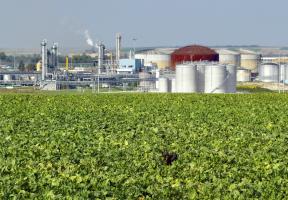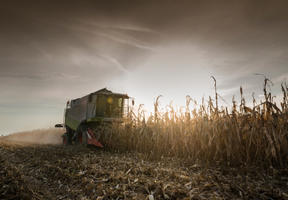Microalgae Biomass Conversion
10 min read
Researchers are highly enthusiastic about the potential use of algal , which could significantly broaden the scope of biotechnological development and help produce an extremely wide variety of products. However, the prospect of mass-producing economically viable is still a long way off.

© - Microalgae cultivation ponds at the Le Vigeant site near Poitiers in central France – home to a research center for algal biomass conversion. ©AFP
Algal biomass offers significant potential worldwide. Of the hundreds of thousands of species found in nature, around 300 to date have been identified as having the ability to produce large quantities of oil. Microalgae are already being used in certain industries for small, high value‑added runs of products, such as pigments and omega 3, and display promise in the areas of animal feed and specialty chemicals. Currently, however, the mass-production of algal biofuels and biomethane is still at the research and development stage and is not expected to become sufficiently economically viable for at least ten years.
"Mini-Factories"
Both terrestrial and aquatic plants accumulate energy reserves in the form of oils and sugars to ensure their survival in all situations. Compared with natural selection, the application of biotechnologies to microalgae (and ) offers scientists the ability to make a significant qualitative leap by producing mutant species that can over-accumulate certain substances useful to humankind. The selected species becomes a bona fide "factory" of sorts, ramping up production on request. The microalgae used offer far greater yields per hectare than terrestrial plant species. This scientific potential explains the enormous amount of research being undertaken worldwide.
The first stage of microalgae conversion consists in selecting the strains that show the most promise in producing oils naturally, then genetically modifying their metabolism to optimize output. Next, the algae are cultivated in large open-air ponds or in "bioreactors" made up of transparent tubes. Once they are harvested, the proteins, lipids and carbohydrates are extracted. Finally, the lipids are converted into biofuels.
The methods used to convert the oil into biofuel are the same as for conventional vegetable oils, namely:
- Esterification, where the algal oil reacts with or ethanol to form , which can be blended with regular .
- Catalytic hydrogenation, where the oil reacts in the presence of hydrogen. This process is followed by , which produces hydrocarbons that can be blended with diesel or jet fuel at high concentrations.
Other biochemical and thermochemical pathways also exist for producing ethanol or hydrocarbons that can be mixed with gasoline or diesel.
Advantages and Disadvantages
There are several advantages to converting microalgae compared with terrestrial biomass. For example:
- The yields per hectare can be significantly higher than those of oilseed crops such as rapeseed and even oil palm. Under laboratory conditions, scientists have obtained oil yields per hectare some 20 to 30 times higher than those of terrestrial oilseed crops.
- Algae do not need to be cultivated on arable land, meaning they do not compete with crops for space.
- Algae species with high lipid contents require significant amounts of carbon dioxide to grow, opening the door to the possibility of , or "scrubbing", CO2 emitted by factories or thermal plants.
However, there are still several obstacles to mass production:
- Algae cultivation requires specific sunlight and water availability conditions, limiting the choice of suitable locations. It also needs large amounts of nutrients (nitrates and phosphates) and carbon dioxide. Moreover, extracting the oil is very . For these reasons, an entire supply chain infrastructure would have to be built from scratch to provide this new breed of farms with the raw materials and energy they need.
- Even with optimal levels of sunshine, algae cultivation requires vast amounts of space to achieve large-scale production volumes. It is estimated that a 150-square-kilometer land‑based farm – the equivalent of France's Arcachon Bay – would have an output just one-tenth the size of a large conventional oil refinery in France.
The cost of producing algae-based biodiesel is today estimated at between €5 and €10 per liter, which rules out commercial production. However, more than $2 billion has been invested in over 200 research and development projects, mostly in the United States but also in Europe and China.





















